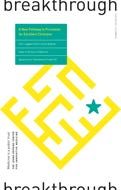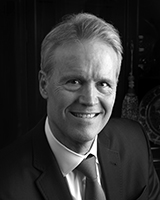

David B. Hellmann,
MD, MACP
When Bill Brody, longtime Johns Hopkins University president, encouraged me to “think big” in creating the Center for Innovative Medicine back in 2005, I took him at his word (p. 10). Today, some 14 years later, I’m gratified to see important CIM initiatives bearing fruit and having a big impact in advancing medicine as a public trust.
Consider the Miller Coulson Academy of Clinical Excellence, which we launched in 2008 to celebrate our doctors who are the “best of the best” at providing patient-centered clinical care. As you’ll learn in this issue (p. 2), the academy has served as the impetus and the model for an entirely new faculty promotion pathway being rolled out this fall at Johns Hopkins. For the first time in the history of the Johns Hopkins University School of Medicine, faculty members who are passionate about providing outstanding patient care now have a clear track for advancement. I’m extremely proud that the rigorous process that Scott Wright and his colleagues established at the Miller Coulson Academy for measuring clinical excellence was so critical in demonstrating to school of medicine leaders that great doctoring can indeed be judged by objective standards. I’m also excited to serve as co-chair of the new Clinical Excellence Promotions Committee, together with psychiatrist Meg Chisolm, a Miller Coulson Academy scholar. With this new promotion track in place, I’m confident that Johns Hopkins will be better equipped than ever to attract – and retain – the best clinicians from across the country and around the world, and our patients will be the beneficiaries.
Of course, there are plenty of other CIM people and projects who are advancing our mission of thinking big – from radiologist Pam Johnson’s efforts at the national level to reduce unnecessary medical testing while advancing “high-value” medical care (p. 12), to addiction specialist Michael Fingerhood’s leadership of the Comprehensive Care Practice, which celebrates its
25th anniversary this year (p. 6). Established at a time when Baltimoreans struggling with addiction and HIV had few options for primary care, the program has saved the lives of countless Baltimoreans and provided hope to many, many more.
None of this important work would be possible without your generous support, and for that, all of the members of the Center for Innovative Medicine and I are immensely grateful.

Aliki Perroti Professor of Medicine;
Vice Dean, Johns Hopkins Bayview Medical Center;
Chairman, Department of Medicine
Don Willett November 9th, 2019
Posted In:
 For years, Scott Wright found himself flummoxed when advising excellent clinicians in his division who were looking to be promoted at Johns Hopkins. “As a division chief, I have faculty members who are just outstanding when it comes to providing patient care. That is their passion and what they love to do. But unless they were willing to spend time away from patients, writing grant proposals and doing research, there was no way forward,” says Wright, the Anne Gaines and G. Thomas Miller Professor of Medicine.
For years, Scott Wright found himself flummoxed when advising excellent clinicians in his division who were looking to be promoted at Johns Hopkins. “As a division chief, I have faculty members who are just outstanding when it comes to providing patient care. That is their passion and what they love to do. But unless they were willing to spend time away from patients, writing grant proposals and doing research, there was no way forward,” says Wright, the Anne Gaines and G. Thomas Miller Professor of Medicine.
All that changed this fall with the rollout of a new track in clinical excellence. It provides a new path to promotion at Johns Hopkins Medicine – one that will recognize faculty members for their skill and empathy with patients.
“It’s a great day!” says Wright. “We now have a system in place to reward those doctors who spend the majority of their time providing excellent care to patients. Now they, too, can be promoted to the rank of associate professor and full professor!”
Just as gratifying to Wright and others at the Center for Innovative Medicine (CIM) is that the foundation for the new promotion pathway was laid by CIM’s Miller Coulson Academy of Clinical Excellence, which launched in 2008 with Wright as director.
“As an institution, we pride ourselves on doing things rigorously and objectively, but up until the Miller Coulson Academy, there was general skepticism that clinical excellence could be measured in a clear and consistent way,” says Cynthia Rand, senior associate dean for faculty. “But the Miller Coulson Academy really made a mark, both locally at Johns Hopkins and nationally, by developing a truly rigorous process – including extensive internal and external peer review and objective clinical metrics – for measuring excellence in clinical care.”
Each year, only a small percentage of the most respected physicians who are invited to apply to the academy (after having been nominated by many peers) are ultimately offered membership. One key element to the process is external evaluation: Master clinicians from top academic institutions around the country review and score the clinical portfolios that are submitted. When building their portfolios, applicants must provide the names of 10 patients, 10 physician peers, 10 learners and 10 non-physician clinical providers (e.g., nurses and medical assistants) who provide confidential assessments across eight domains of clinical excellence.
“We now have a system in place to reward those doctors who spend the majority of their time providing excellent care to patients. Now they, too, can be promoted to the rank of associate professor and full professor!”
“As the Miller Coulson Academy advanced,” says Rand, “we were able to use its groundbreaking work as part of our rationale in our presentation to school of medicine leaders that yes, indeed, we do know how to measure clinical excellence fairly and to create a rigorous promotional pathway. Without the Miller Coulson Academy, we never would have been able to successfully make that argument.”
A new Clinical Excellence Promotions Committee, led by CIM Director David Hellmann and psychiatrist Meg Chisolm, herself a Miller Coulson Academy member, will review promotion applications in the clinical excellence track. The first applicants will likely be Miller Coulson inductees (now numbering more than 90). In addition to demonstrating their strength in clinical care, successful applicants must also shine outside the clinic by actively disseminating clinical excellence scholarship at regional and national levels, teaching, and participating in the discovery mission. Rand expects to see the first candidates move through the process, and potentially earn their new ranks, by late 2019 or early 2020.
She notes that those who worked on the initiative (including Wright; David Eisele, director of otolaryngology–head and neck surgery; and Janice Clements, vice dean for faculty in the school of medicine) were intentional in their naming of the new track.
“The Miller Coulson Academy really gave us the ‘bones’ for building this new pathway, and we wanted to be very clear that ‘excellence’ is key to how clinicians will be evaluated,” Rand says. “While we are among the last academic medical centers to establish a promotion pathway for clinicians, we are unique – perhaps even the first – in creating a promotion pathway in clinical excellence.”
“As the Miller Coulson Academy advanced, we were able to use its groundbreaking work as part of our rationale in our presentation to school of medicine leaders that yes, indeed, we do know how to measure clinical excellence fairly and to create a rigorous promotional pathway.”
For his part, Wright says he is overjoyed by what the new promotion pathway will mean for his efforts to recruit and retain top doctors. “Now, when I’m talking to our residents, who are all about providing great patient care, I can say, ‘There is now a path for you to join our faculty and move through the ranks here, based on your passion.’ I couldn’t be happier.”
Don Willett November 9th, 2019
Posted In:

It’s a familiar sight on the 12th-floor adolescent psychiatry wing at the Johns Hopkins Children’s Center: Grendel, a friendly chocolate-brown Mastiff the size of a polar bear, walks into the lounge for his regular visit with handler Anne Efron, and the eyes of all of the teen patients light up.
“He will plop right down, and before you know
it, eight kids are just loving him to pieces,” says Stephanie Cooper Greenberg, who first launched the pet therapy program at The Johns Hopkins Hospital in 2009. At that time, the hospital had no more than three canine/human handler teams; she and her beloved Dalmatians, Mattilda and Willamina, were among those pilot pairs. She now handles their successors, Olive and Josephine, both Dalmatians.
“I’m proud to say that today, we have grown to more than 20 teams, and we’re training more all the time. We could easily keep 15 more teams busy. The demand has been insatiable!” says Cooper Greenberg, the longtime chair of the Center for Innovative Medicine’s International Advisory Board.
The canine/human teams find a receptive audience everywhere they go: among kids in the pediatric ICUs, Alzheimer’s patients in psychiatry, and adult patients in urology, neurology, stroke, oncology, surgery, medicine, cardiology and even several ICUs. “We go room to room, bed to bed, all over the Children’s Center and The Johns Hopkins Hospital. We also visit at Kennedy Krieger, and we’ve started teams at Johns Hopkins Bayview Medical Center,” says Cooper Greenberg.
“Dogs have a unique way of helping people get through a tough day or a tough moment and bringing them back to themselves.”
She and her team members are inspired by research showing that visits from pets can relieve some of the stress, pain and anxiety related to illness and hospital stays. “When you’ve been doing this as long as I have, you just know that it works,” says Cooper Greenberg. “We distract patients from their day-to-day medical environment, and they are no longer a patient. By having conversations about our dogs and the dogs they have at home, it brings them back to themselves and a world that’s waiting for them at home.”
More recently, in keeping with Johns Hopkins Medicine’s “Joy in Medicine” initiative, which is aimed at mitigating burnout, stress and anxiety among Johns Hopkins clinicians and staff members, Cooper Greenberg is bringing the dog therapy program to medical residents. “We’ve been asked to visit residents in a wide variety of programs, including residents, fellows and staff in pediatrics and ICUs,” she says. “Our teams go into the break rooms, and everyone can giggle and have fun. It’s a true stress reliever.”
The screening and training process for those who want to join the program at Johns Hopkins is rigorous and stretches over six to nine months. More than half of those currently serving, like Efron (who is a project administrator with the Center for AIDS Research), are Johns Hopkins staff members.
“We will take dogs of any size, age or breed, but the handler must first be registered with one of two pet therapy programs – Pet Partners or National Capital Therapy Dogs – and once we’ve screened them, we run them through an in-house training program and then observe and evaluate them to match each team with the right unit,” explains Cooper Greenberg. A young dog, for example, might be too excitable to serve on a children’s wing; instead, a calmer and steadier older canine (such as Grendel the Mastiff) would be a better fit. “We take a lot of time to make sure these are the right dogs for our medical units,” she says. “It can be very exhausting to go room to room, over several hours, and that’s not always a good fit.”
Some canines who aren’t judged a good match for hospital visits instead find a niche as a “reading dog.” Through a program Cooper Greenberg first launched at a public library that is now being rolled out at the Kennedy Krieger Institute, reading dogs snuggle up with kids as they work on their reading skills. Some children who might be shy, or less than enthusiastic about reading aloud to an adult, find a welcome partner in a canine reading buddy, she notes.
Whether they are helping with young readers or visiting someone sick in the hospital, she says, “Dogs have a unique way of helping people get through a tough day or a tough moment and bringing them back to themselves. It’s been the singular joy of my life to be a part of this, and I’m proud that this program resonates so well with the mission of the Center for Innovative Medicine and its efforts to promote medicine as a public trust.”
Don Willett November 9th, 2019
Posted In:

East Baltimore resident Monaye Gethers started using heroin in her late teens and discovered she was HIV-positive at 27. Two years later, she quit using – not just heroin, but alcohol, marijuana and any other substance that might cross her path. She went back to school, bought a house and car, and launched a career in substance use counseling – but for all she’d been through, she’d never had a doctor she trusted.
“All the doctors I’d met knew nothing about an African American woman in recovery with HIV,” she recalls today. “They didn’t even want to touch you, and everything that was wrong with you – even if you came in with a backache – had to be the HIV. Or, when I was using, it was the drugs.”
Then a friend recommended she see a doctor at Johns Hopkins who had started a clinic that focused on providing primary care to people with HIV and substance use disorders. That doctor’s name was Michael Fingerhood.
“We just hit it off,” recalls Gethers. “He wanted to know everything about me – we sat in his office and talked for 45 minutes – before he even put a stethoscope to my chest. And then he examined me, and I showed him a rash and said it was probably the HIV, and he said, ‘No, that’s just topical dermatitis.’ When I came back for a follow-up to talk about my bloodwork, he said I was in great health.”
“Addiction certainly doesn’t define the people who come to our practice. But it does need to inform the care we provide them.”
Gethers is just one of thousands of patients whose lives have been transformed by Fingerhood and the Comprehensive Care Practice that he launched at Johns Hopkins Bayview Medical Center back in 1994. Established at a time when many Baltimoreans struggling with addiction had few options for health care, the practice, which receives some funding from the Center for Innovative Medicine (CIM), has provided judgment-free support to people fighting dependence on drugs or alcohol for the past 25 years.
Heroin, fentanyl and other opioids are the most common substances Fingerhood and his team see, but the practice also treats patients with alcohol, cocaine and other substance use problems. More than 6,000 people, many of whom have been sober or off drugs for years, rely on the practice for routine medical care.
“Addiction certainly doesn’t define the people who come to our practice. But it does need to inform the care we provide them,” says Fingerhood.
Fingerhood, a member of the Miller Coulson Academy of Clinical Excellence, proudly declares he doesn’t own a white physician’s coat. “For me, they just kind of create a barrier between me and patients,” he says. “Not my style.”
It’s that kind of accessible, down-to-earth approach that has earned Fingerhood the respect of his colleagues (see sidebar on p. 7) and the gratitude and loyalty of his patients.
“My sobriety is the first thing Dr. Fingerhood asks about when I see him,” says a longtime patient who battles alcoholism. “He’ll ask if I’m still going to my Alcoholics Anonymous meetings and talking to my sponsor. I haven’t used in almost 20 years, but it’s still something I have to pay attention to. Going to Dr. Fingerhood helps keep me grounded.”
Another patient tells of relapsing after many years of sobriety, when two close family members died. She subsequently overdosed on heroin seven times between June and August 2017. Several of those overdoses were nearly fatal. “Dr. Fingerhood helped me through the most difficult time in my life,” she says. “He just never gives up on me.”
Earlier this year, Fingerhood was tapped by Johns Hopkins University President Ronald Daniels to lead a universitywide effort – involving researchers and clinicians at the schools of medicine, nursing and public health – to reduce opioid addiction in Baltimore.
Fingerhood has turned to a team of five community leaders in East Baltimore to help guide the ambitious universitywide project. Six months in, he’s encouraged by the progress. “A lot of recent research says that access to buprenorphine is important when communities are fighting against opioids,” he says, referring to a prescription medication used to treat addiction. The Substance Abuse and Mental Health Services Administration requires providers to obtain special certification to prescribe buprenorphine. As part of the plan he outlined with Daniels, Fingerhood has led an effort to get as many clinicians as possible to obtain that certification.
Given the scope of opioid addiction we face today, it might seem like Fingerhood and the Comprehensive Care Practice face a daunting, uphill battle. But Fingerhood emphasizes that there is real reason for hope.
“At the Comprehensive Care Practice, our six-month retention rate for people with opioid addiction who we treat with buprenorphine is 80 percent.”
“At the Comprehensive Care Practice, our six-month retention rate for people with opioid addiction who we treat with buprenorphine is 80 percent,” he says. “By way of comparison, with a typical smoking cessation program, we’d usually see about a 15 percent retention rate.
“So you can see that 80 percent is an incredible rate – and a real cause for celebration that we are able to help so many of the patients who come to us.”
Don Willett November 9th, 2019
Posted In:
 Mark Anderson, director of the Department of Medicine and physician-in-chief of The Johns Hopkins Hospital, conducts his research in a state-of-the-art lab, using cutting-edge tools, like genetically engineered CRISPR mouse models. But in explaining the hows and whys of his bench science, which holds the potential for tantalizing new insights into the mechanisms of how we age, he goes back to a much, much simpler time: 1 billion years ago.
Mark Anderson, director of the Department of Medicine and physician-in-chief of The Johns Hopkins Hospital, conducts his research in a state-of-the-art lab, using cutting-edge tools, like genetically engineered CRISPR mouse models. But in explaining the hows and whys of his bench science, which holds the potential for tantalizing new insights into the mechanisms of how we age, he goes back to a much, much simpler time: 1 billion years ago.
“We can only understand the genetics of disease in the context of evolution,” says the physician/scientist, who was elected to the National Academy of Medicine in 2017.
This was a period when invertebrates alone ruled the Earth – floating in the water and clinging to rocks. Scientists have shown that even back then, a protein known as CaMKII (Ca2+/calmodulin dependent kinase II) existed in living matter.
Fast forward half a billion years, when vertebrates made their debut: CaMKII assumed a more starring role, Anderson says, noting, “Animals evolved to have a head and a gut and a spine. They developed a rich skeletal system, and we know that skeletal muscle, heart muscle and brain tissue all have lots of the CaMKII enzyme.” Scientists assumed that the enzyme played a key role in the “fight or flight” response of evolving vertebrates. “Animals weren’t stuck to a rock anymore, and they had to move fast to catch prey or get out of the way of a predator,” says Anderson.
But what kind of role – and why?
Crucially, it was at this point in evolutionary history that a pair of amino acids known as methionines first arrived on the scene, Anderson explains. “And they have been conserved throughout speciation ever since, without a blip. Somehow, evolution decided these amino acids were to be cherished – that they played a very important role.”
Anderson and his colleagues spent more than five arduous years in the lab in a project led by Qinchuan Wang, a molecular biologist, and Gabriel Bever, an evolutionary biologist, teasing out the intertwined roles of methionines and CaMKII, using fruit fly models and genetically engineered mice. Ultimately, Anderson and his team showed something compelling: The methionines are modified during increased oxidative stress and lead to CaMKII activation.
“Evolution equipped animals to be a little faster and better at getting away from predators, but the cost is that when they get older, they become susceptible to diseases linked to too much oxidation.”
This increase in CaMKII activity improves physiologic (fight or flight) performance by actions in skeletal muscle – but at the cost of increased oxidative damage to the cardiovascular system and promotion of other common diseases, notes Anderson, whose own research has focused on the role that CaMKII plays in heart failure and cardiac arrhythmias, a cause of sudden cardiac death.
In genetically engineered mice in which methionine is “knocked out,” Anderson explains, the CaMKII enzyme is normal – except that it can’t be activated by oxidation. The result: The knockout mice are more resistant to disease. But the flip side is that they can’t run as fast or as far; they are not physically robust.
“It’s an evolutionary trade-off,” says Anderson. “Evolution equipped animals to be a little faster and better at getting away from predators, but the cost is that when they get older, they become susceptible to diseases linked to too much oxidation.”
Which brings us to how Anderson’s ongoing research on CaMKII could provide important clues to healthier aging. “It’s not just diseases where oxidant stress is a culprit,” he says. “Oxidation almost certainly plays a role in accelerated aging.
“So it’s reasonable to think that these oxidation sites that we’ve identified are markers of the aging process,” he says. “Ultimately, our hope is that they can provide us with insights into how oxidant stress contributes to the diseases of aging.”
Don Willett November 9th, 2019
Posted In: